by Bruce Wells | May 6, 2025 | Energy Education Resources
Preserving Louisiana petroleum history at Caddo Lake.
A 1905 oil discovery at Caddo-Pines brought America’s rapidly growing petroleum industry to northwestern Louisiana. A state museum in appropriately named Oil City tells the story.
Originally the Caddo-Pine Island Oil and Historical Museum, in May 2004 the Louisiana State Oil and Gas Museum was dedicated as a state museum under the Louisiana Secretary of State.
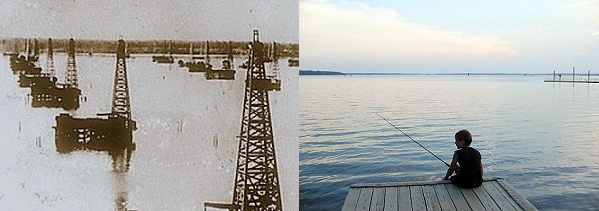
Gulf Refining Company in 1911 built drilling platforms to reach the oil beneath Caddo Lake, Louisiana. The early “offshore” technologies worked, and production continues today.
Located about 20 miles north of Shreveport, the first public museum in Louisiana dedicated to the petroleum industry maintains an extensive local history library and collected photographic archives. Exterior exhibits include the former depot of the Kansas City Southern Railroad. (more…)
by Bruce Wells | Mar 24, 2025 | This Week in Petroleum History
March 24, 1989 – Exxon Valdez hits Bligh Reef –
After almost 12 years of routine passages by oil tankers through Prince William Sound, Alaska, supertanker Exxon Valdez ran aground on Bligh Reef, resulting in an oil spill affecting 1,300 miles of shoreline. Vessels carrying North Slope oil had safely passed through the sound more than 8,700 times.
Eight of Exxon Valdez’s 11 tanks were punctured and an estimated 260,000 barrels of oil spilled, affecting hundreds of miles of coastline. Investigators later found that an error in navigation by the third mate, possibly due to fatigue or excessive workload, had caused the accident.

Shown being towed away from Bligh Reef, the Exxon Valdez had been outside shipping lanes when it ran aground in March 1989. Photo courtesy Erik Hill, Anchorage Daily News.
When the 987-foot tanker hit the reef that night, “the system designed to carry two million barrels of North Slope oil to West Coast and Gulf Coast markets daily had worked perhaps too well,” noted the Alaska Oil Spill Commission. “At least partly because of the success of the Valdez tanker trade, a general complacency had come to permeate the operation and oversight of the entire system.”
Learn more in Exxon Valdez Oil Spill.
March 26, 1930 – “Wild Mary Sudik” makes Headlines
What would become one of Oklahoma’s most famous wells struck a high-pressure formation about 6,500 feet beneath Oklahoma City and oil erupted skyward. The Indian Territory Illuminating Oil Company’s Mary Sudik No. 1 flowed for 11 days before being brought under control. It produced about 20,000 barrels of oil and 200 million cubic feet of natural gas daily, becoming a worldwide sensation.

Highly pressured natural gas from the Wilcox formation proved difficult to control in the prolific Oklahoma City oilfield. Within a week of a 1930 gusher, Hollywood newsreels of it appeared in theaters across America. Photo courtesy Oklahoma History Center.
Efforts to control the well in Oklahoma City’s prolific oilfield (discovered in 1928) were featured on movie newsreels and national radio broadcasts. It was later learned that after drilling more than a mile deep, the exhausted crew did not realize the Wilcox Sand oil formation was permeated with highly pressurized natural gas.
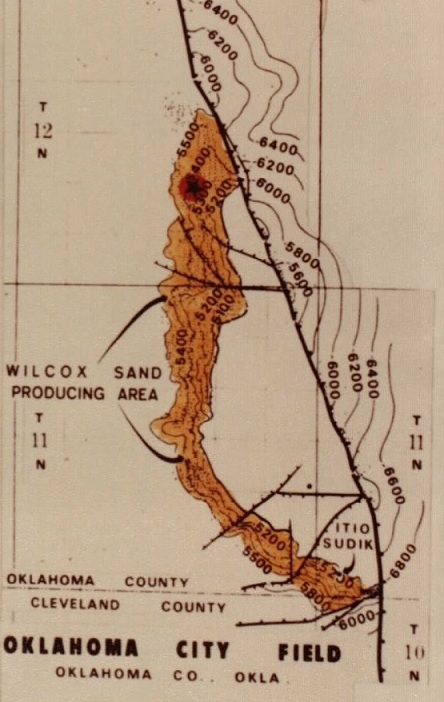
Map of the Wilcox sands formation of the Oklahoma City oilfield in the 1940s.
Although the first ram-type blowout preventer (BOP) had been patented in 1926, deep oil and natural gas fields would take time to tame.
Learn more in “Wild Mary Sudik.”

March 27, 1855 – Canadian Chemist trademarks Kerosene
Canadian physician and chemist Abraham Gesner (1797-1864) patented a process to distill coal into kerosene. “I have invented and discovered a new and useful manufacture or composition of matter, being a new liquid hydrocarbon, which I denominate Kerosene,” he proclaimed. Because his new illuminating fluid was extracted from coal, consumers called it “coal oil” as often as kerosene.
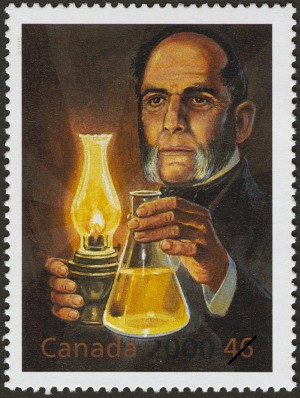
On March 17, 2000, Canada issued one million commemorative stamps featuring kerosene inventor Abraham Gesner.
Gesner, considered the father of the Canadian petroleum industry, in 1842 established Canada’s first natural history museum, the New Brunswick Museum, which today houses one of Canada’s oldest geological collections. America’s petroleum industry began when it was learned oil could be distilled into a lamp fuel.
Learn more in Camphene to Kerosene Lamps.
March 27, 1975 – First Pipe laid for Trans-Alaskan Pipeline
With the laying of the first section of pipe in Alaska, construction began on the largest private construction project in American history at the time. Recognized as a landmark of engineering, the 800-mile Trans-Alaska Pipeline system, including pumping stations and the Valdez Marine Terminal, would cost $8 billion by the time it was completed in 1977.
Learn more in Trans-Alaska Pipeline History.
March 27, 1999 – Offshore Platform Rocket Launch Test
The Ocean Odyssey, a converted semi-submersible drilling platform, launched a Russian rocket that placed a demonstration satellite into geostationary orbit.
The Zenit-3SL rocket, fueled by liquid oxygen and kerosene rocket fuel, was part of Sea Launch, a Boeing-led consortium of companies from the United States, Russia, Ukraine, and Norway. The platform had once been used by Atlantic Richfield Company (ARCO) for North Sea exploration.
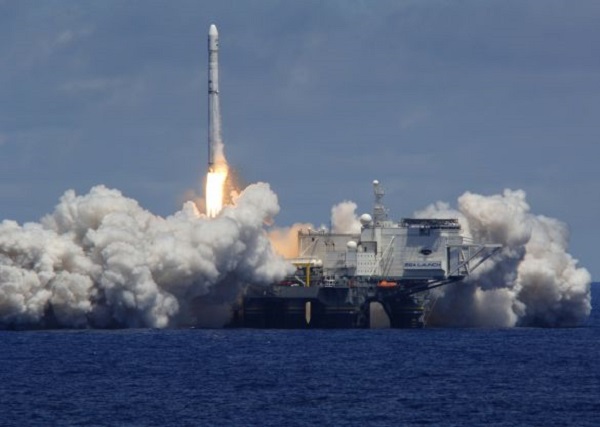
With an orbital test on March 27, 1999, the Ocean Odyssey, a converted semi-submersible drilling platform, became the world’s first floating equatorial launch pad. Photo courtesy Sea Launch.
“The Sea Launch rocket successfully completed its maiden flight today,” Boeing announced. “The event, which placed a demonstration payload into geostationary transfer orbit, marked the first commercial launch from a floating platform at sea.”
The Sea Launch consortium provided orbital launch services until 2014, when Russia annexed the Crimean Peninsula of Ukraine.
Learn more in Offshore Rocket Launcher.

March 28, 1886 – Natural Gas Boom begins in Indiana
Petroleum exploration companies converged on Portland, Indiana, after the Eureka Gas and Oil Company discovered a natural gas field after drilling just 700 feet deep. The well began producing two months after a spectacular natural gas well about 100 miles to the northeast — the “Great Karg Well” of Findlay, Ohio.

According to industrialist Andrew Carnegie, natural gas daily replaced 10,000 tons of coal for making steel.
Portland foundry owner Henry Sees had followed the news from Findlay. He persuaded local investors to drill for Indiana natural gas. In western Pennsylvania, reserves found near Pittsburg had encouraged industrialists there to replace their coal-fired steel and glass foundries with the first large-scale industrial use of natural gas.
Indiana would become the world’s largest natural gas producer, thanks to its Trenton limestone stretching more than 5,100 square miles across 17 counties. Within three years, more than 200 companies were drilling, distributing, and selling natural gas.
Learn more in Indiana Natural Gas Boom.
March 28, 1905 – Oil Discovered in North Louisiana
A small oil discovery in Caddo Parish launched a drilling boom in northern Louisiana and brought economic prosperity to Oil City. The Offenhauser No. 1 well was completed at a depth of 1,556 feet, but yielded just five barrels of oil a day and was abandoned. Far more productive wells quickly followed as the Caddo-Pine Island oilfield 20 miles northwest of Shreveport expanded into 80,000 acres.

The Shreveport Chamber of Commerce in 1955 dedicated a 40-foot monument commemorating the 50th anniversary of oil in Caddo Parish. Photo by Bruce Wells.
“This part of Louisiana, of course, was built on the oil and gas industry, and those visitors interested in the technical aspects of oilfield work will find the museum particularly appealing,” notes the Louisiana State Oil and Gas Museum (formerly the Caddo-Pine Island Oil and Historical Museum). More oilfield history can be found in Shreveport, where natural gas was discovered in 1870 — thanks to an ice plant’s water well. To discourage natural gas flaring, Louisiana passed its first conservation law in 1906.
Learn more in Louisiana Oil City Museum.
March 29, 1819 – Birthday of Father of the Petroleum Industry
Edwin Laurentine Drake (1819-1880) was born in Greenville, New York. Forty years later, he used a steam-powered cable-tool rig to drill the first commercial U.S. oil well at Titusville, Pennsylvania. The former railroad conductor overcame many financial and technical obstacles to make “Drake’s Folly” a milestone in U.S. petroleum history.
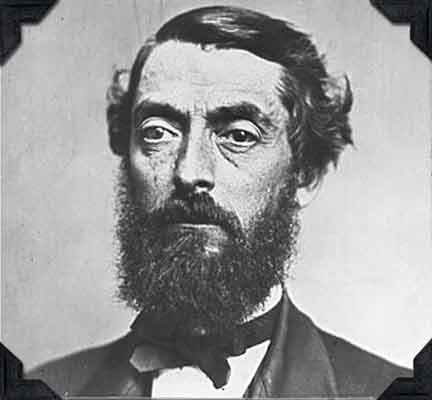
Edwin L. Drake (1819-1880) invented a method of driving a pipe down to protect the integrity of the first U.S. oil well. Photo courtesy Drake Well Museum.
Drake pioneered using iron casing to isolate his well from nearby Oil Creek. “In order to overcome the hurdles before him, he invented a ‘drive pipe’ or ‘conductor,’ an invention he unfortunately did not patent,” noted historian Urja Davé in 2008. “Mr. Drake conceived the idea of driving a pipe down to the rock through which to start the drill.”
Determined to find oil for refining into kerosene, Drake drilled near natural seeps and found oil on August 27, 1859, at a depth of 69.5 feet at a site today on the grounds of the Drake Well Museum.
Learn more in Edwin Drake and his Oil Well.

March 29, 1938 – Magnolia Oilfield found in Arkansas
“Kerlyn Wildcat Strike In Southern Arkansas is Sensation of the Oil Country,” proclaimed the local newspaper when a well drilled by Kerlyn Oil Company revealed the 100-million-barrel Magnolia oilfield, adding to the 1920s giant oilfield discoveries at El Dorado and Smackover.
Drilling on the Barnett No. 1 well had been suspended because of a lack of money, but geologist and company Vice President Dean McGee urged drilling deeper. He was rewarded with a giant oilfield discovery at the depth of 7,650 feet. McGee later would become an industry pioneer in offshore exploration.
Visit the Arkansas Museum of Natural Resources in Smackover.
March 30, 1980 – Deadly North Sea Gale
Massive waves during a North Sea gale capsized a floating apartment for Phillips Petroleum Company workers, killing 123 people. The Alexander Kielland platform, 235 miles east of Dundee, Scotland, housed 208 men who worked on a nearby rig in the Ekofisk field. Most of the Phillips workers were from Norway. The platform, converted from a semi-submersible drilling rig, served as overflow accommodation for the Phillips production platform 300 yards away.
_______________________
Recommended Reading: The Exxon Valdez Oil Spill, Perspectives on Modern World History (2011); The Oklahoma Petroleum Industry
(2011); The Oklahoma Petroleum Industry (1980); Oil Lamps The Kerosene Era In North America
(1980); Oil Lamps The Kerosene Era In North America (1978); Amazing Pipeline Stories: How Building the Trans-Alaska Pipeline Transformed Life in America’s Last Frontier
(1978); Amazing Pipeline Stories: How Building the Trans-Alaska Pipeline Transformed Life in America’s Last Frontier (1997); The Extraction State, A History of Natural Gas in America (2021); Myth, Legend, Reality: Edwin Laurentine Drake and the Early Oil Industry
(1997); The Extraction State, A History of Natural Gas in America (2021); Myth, Legend, Reality: Edwin Laurentine Drake and the Early Oil Industry (2009); Texas Oil and Gas, Postcard History
(2009); Texas Oil and Gas, Postcard History (2013); Early Louisiana and Arkansas Oil: A Photographic History, 1901-1946
(2013); Early Louisiana and Arkansas Oil: A Photographic History, 1901-1946 (1982). Your Amazon purchase benefits the American Oil & Gas Historical Society. As an Amazon Associate, AOGHS earns a commission from qualifying purchases.
(1982). Your Amazon purchase benefits the American Oil & Gas Historical Society. As an Amazon Associate, AOGHS earns a commission from qualifying purchases.
_______________________
The American Oil & Gas Historical Society (AOGHS) preserves U.S. petroleum history. Please become an AOGHS annual supporter and help maintain this energy education website and expand historical research. For more information, contact bawells@aoghs.org. Copyright © 2025 Bruce A. Wells. All rights reserved.
by Bruce Wells | Mar 3, 2025 | Petroleum Companies
Louisiana oil boom brings pipelines, refineries and competition.
Claiborne Parish made headlines on January 12, 1919, when Consolidated Progressive Oil Company completed the discovery well for northern Louisiana’s prolific Homer oilfield. About 50 miles to the west, a 1905 oil discovery at Caddo-Pines near Shreveport had brought a rush of oil exploration to northern Louisiana.
Caddo Lake drilling platforms – completed over water without a pier to shore – have been called America’s first true offshore oil wells. Exhibits at the state’s Oil City museum tell that story. Like Caddo-Pines, the Homer field was crowded with new companies within months after the discovery.
Petroleum production from the new field soon reached an aggregate of about 10,000 barrels of oil per day. Reporting from the Pennsylvania oil regions, Pittsburgh Press on September 21, 1919, proclaimed the “Homer Field is Sensation of Oil Industry.”
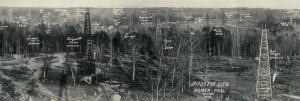
Detail from a panoramic “bird’s eye view” of the Homer oilfield circa 1920s. Photo courtesy Library of Congress Prints and Photographs Division, Washington, D.C.
Superior Oil Works
Paramount Petroleum Company began when the leadership of another company operating in the Homer oilfield decided to expand operations. Superior Oil Works officers, including President George A. Todd of Oklahoma City; Secretary and Purchasing Agent H.H. Todd of Vivian, Louisiana; and Treasurer D.C. Richardson of Shreveport organized the Paramount Petroleum Company.
Superior Oil Works had been formed to build and operate a refinery close to the Homer field. Capitalized at $300,000 with common stock issued, the company began construction in Superior, Louisiana, but its officers were by then contemplating the much-expanded venture — the formation of Paramount Petroleum to integrate exploration, production, transportation and refining under one organization.
Once established, the new company absorbed Superior Oil Works and looked for potential leases near the Consolidated Progressive Oil Company’s discovery well. As construction of the Superior refinery progressed, purchasing agent H.H. Todd advertised that Paramount Petroleum was “in the market for oil refinery equipment, boilers, stills, pumps, and plant machinery, etc.”
Paramount Petroleum made a deal with Consolidated Progressive Oil in May 1919, securing one-half interest in more than 11,000 acres of both proven and unexplored territory in Claiborne Parish. The acreage was already producing about 40,000 barrels of oil, ensuring the refinery would be supplied.
“A giant refining company has been organized recently in Shreveport to be known as the Paramount Petroleum Company,” noted the Oil Distribution News. The venture was capitalized at $10 million with half of its stock subscribed.

“Stock in this company has been consumed by the largest business and banking men of Shreveport,” added the Oil and Gas News. But the best news for investors was the headline: “Paramount Petroleum Gets 10,000 Barrel Well And Will Build Big Refinery.”
In March 1920, the Petroleum Age reported Paramount Petroleum “recently took over the under-construction Superior Oil Works refinery at Vivian [Superior], Louisiana, 23 miles north of Shreveport, to service Pine Island production.”
The publication added that another refinery was to be completed in north Shreveport in November 1920 “with a four-inch pipeline from the Homer field where Paramount Petroleum holds 4,700 acres.”
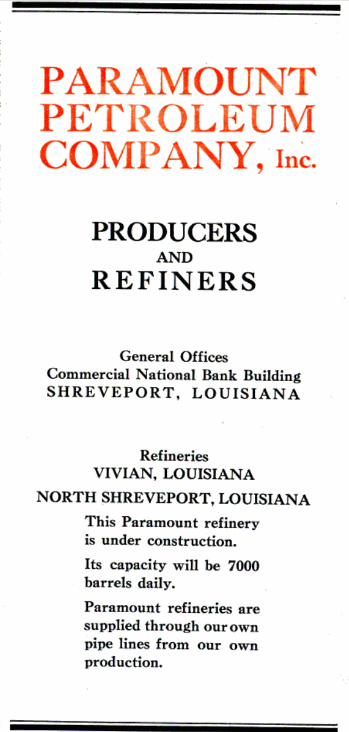
Paramount Petroleum Company’s newest refinery would be struggling by May 1921.
Within a month Paramount Petroleum was drilling in Claiborne Parish and shipping 400,600 barrels of oil a day. The company secured a $1 million mortgage from the Commercial National Bank of Shreveport and advertised, “Paramount refineries are supplied through our own pipelines from our own production.”
Paramount Petroleum in July 1920 completed the No. 5 Shaw well, which produced 500 barrels of oil a day from 2,090 feet deep in the Homer field. In August, the company’s No. 9 Shaw well become another 500-barrels-of-oil-a-day producer from a depth of 2,100 feet.
Anticipating more growth in oil production, Paramount Petroleum committed to an agreement for 300 tank cars from Standard Tank Car Company of St. Louis, Missouri.
“Not too bright”
“Paramount has just closed a deal for one half interest in 24 producing wells in the old Caddo field with 1,200 acres of proven territory on which many wells can yet be drilled,” reported the Petroleum Age in October 1920. “The production department of Paramount Petroleum is making splendid headway and with its large acreage, will no doubt greatly add to the earnings of the company.”
But the Petroleum Age reporter had got it wrong. By February 1921, Paramount Petroleum’s refinery at Superior was running at only about 50 percent capacity. Another trade publication reported the company’s prospects as “not too bright.”
Shipments from Paramount Petroleum’s Homer oilfield holdings dropped to just 168 barrels of oil a day. In May 1921 the struggling company leased its underused refinery and fleet of 390 tank cars to Lucky Six Oil Company for six months.
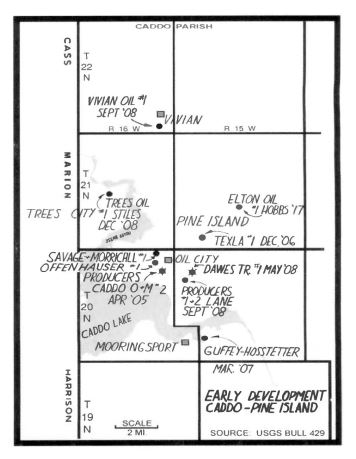
The Homer field attracted drillers from earlier discoveries at the nearby Caddo-Pines oilfields. Photo courtesy the Petroleum History Institute.
To the south, the Busey-Armstrong No. 1 oil gusher on January 10, 1921, had opened Arkansas’ El Dorado field and Lucky Six Oil Company had entered the scramble to exploit the new field’s huge production (578,000 barrels of oil in the month of May alone).
The oilfield discovery 15 miles north of the Louisiana border was the first Arkansas oil well. It attracted even more exploration and production companies to the region.
As competition intensified, Paramount Petroleum struggled to pay debts. It was unable to make a required $200,000 mortgage payment to Commercial National Bank of Shreveport in July 1921. The deal Paramount had struck with Consolidated Progressive Oil back in 1919 had become toxic.

The National Petroleum News reported on September 7, 1921, that Consolidated Progressive Oil was seeking a court-ordered receiver to take over Paramount Petroleum. The action was based on claims totaling $849,547 — and “averred acts jeopardizing the interests of creditors.” Among the allegations was “the effect that officials of the defendant concern have admitted in writing the company’s inability to meet present and maturing obligations.”
Paramount Petroleum’s epitaph was brief. “It is officially stated that this company is out of business,” reported Poor’s Cumulative Service in December 1921. “Its properties are to be sold by the sheriff December 24 and proceeds applied on the first Mortgage notes.”
The first Louisiana oil well had been drilled 17 years before the end of Paramount Petroleum. More stories about petroleum exploration and production companies trying to join drilling booms (and avoid busts) can be found in an updated series of research at Is my Old Oil Stock worth Anything?
______________________
Recommended Reading: Louisiana’s Oil Heritage, Images of America (2012); Early Louisiana and Arkansas Oil: A Photographic History, 1901-1946
(2012); Early Louisiana and Arkansas Oil: A Photographic History, 1901-1946 (1982). Your Amazon purchase benefits the American Oil & Gas Historical Society. As an Amazon Associate, AOGHS earns a commission from qualifying purchases.
(1982). Your Amazon purchase benefits the American Oil & Gas Historical Society. As an Amazon Associate, AOGHS earns a commission from qualifying purchases.
_______________________
The American Oil & Gas Historical Society (AOGHS) preserves U.S. petroleum history. Please become an annual AOGHS supporter and help maintain this energy education website and expand historical research. For more information, contact bawells@aoghs.org. Copyright AOGHS © 2025
Citation Information – Article Title: “Paramount Petroleum Company.” Authors: B.A. Wells and K.L. Wells. Website Name: American Oil & Gas Historical Society. URL:httpshttps://aoghs.org/old-oil-stocks/paramount-petroleum-company. Last Updated: March 9, 2025. Original Published Date: August 15, 2015.
by Bruce Wells | Sep 10, 2024 | Petroleum Pioneers
Acadia Parish oil seeps inspired 1901 Jennings oilfield discovery.
The first Louisiana oil well in 1901 revealed the giant Jennings field and launched the Pelican State’s petroleum industry. By 1911, offshore exploration included barges, floating pile drivers, and drilling platforms on Caddo Lake.
Nine months after the 1901 “Lucas Gusher” at Spindletop, Texas, oil erupted 90 miles to the east in Louisiana. W. Scott Heywood — already a successful wildcatter at Spindletop — drilled the discovery well of the Jennings oilfield. His September 21, 1901, gusher initially produced 7,000 barrels of oil a day.
Louisiana’s first commercial oil well was completed on the Jules Clements farm, about seven miles northeast of the small town of Jennings.
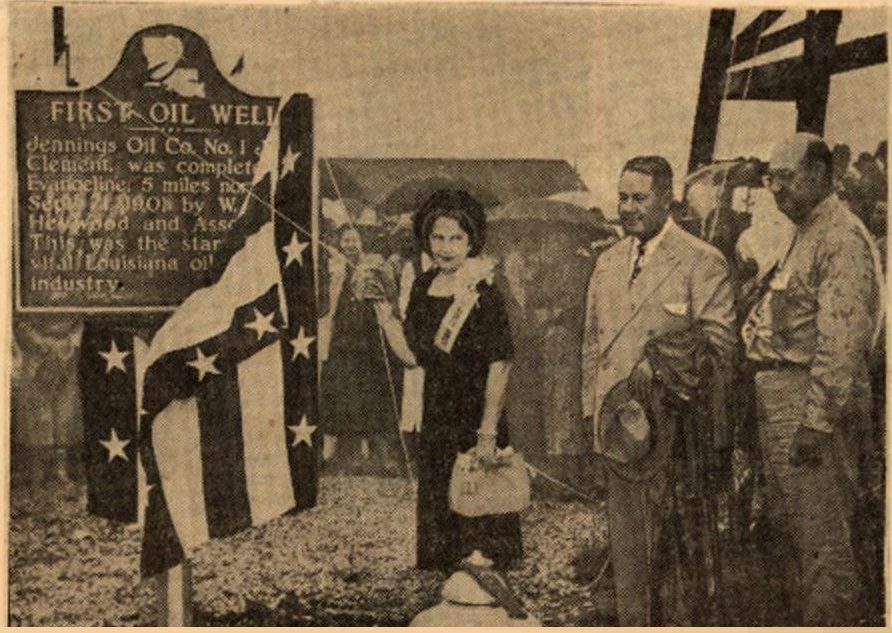
Mrs. Scott Heywood, “the widow of Louisiana’s oil discoverer, the late W. Scott Heywood,” unveiled a historical marker on September 23, 1951, as part of the Louisiana Golden Oil Jubilee. Times Picayune (New Orleans) image courtesy Calcasieu Parish Public Library.
Local investors earlier had formed the Jennings Oil Company and hired Scott, who recognized that natural gas seeps found nearby were nearly identical to the conditions observed at Spindletop.

Scott would insist on drilling deeper than many investors thought wise.
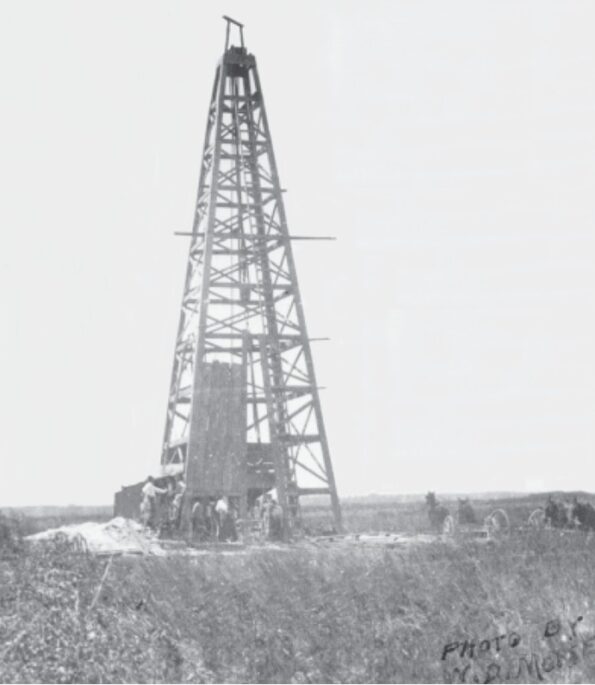
The Jennings Oil Company No. 1 well, which discovered the first commercial oilfield in Louisiana on September 21, 1901. Photo courtesy Louisiana Geological Survey.
“At the age 29, W. Scott Haywood was already a seasoned, experienced and successful explorer,” noted Scott Smiley, a Louisiana Geological Survey (LGS) historian. “He had gone to Alaska in 1897 during the great Yukon gold rush, sinking a shaft and mining a profitable gold deposit.”
Haywood, who also had drilled several successful oil wells in California, was one of the first to reach Spindletop following news of the January 1901, oilfield discovery. Haywood eventually convinced the reluctant Clements to allow drilling in the farmer’s Acadia Parish rice field. The Clements farm was at the small, unincorporated community of Evangeline, northeast of Jennings.

W. Scott Heywood discovered Louisiana’s Jennings field.
However, after drilling to 1,000 feet without finding oil or natural gas, the Jennings Oil Company’s investors wanted to abandon the first attempt.

“After all, 1,000 feet had been deep enough to discover the tremendous oil gushers at Spindletop field,” explained Smiley in a 2001 history of the Jennings field. “Instead of drilling two wells to a depth of 1,000 feet each, Heywood persuaded the investors to change the contract to accept a single well drilled to a depth of 1,500 feet.”
More drilling pipe was brought in and the well deepened.
Deeper Drilling Pays Off
Heywood found signs of oil at a depth of 1,700 feet – after some discouraged investors had sold their stock when drilling reached 1,000 feet. By 1,500 feet, shares of the Jennings Oil Company still sold for as little as 25 cents each. Patient investors were rewarded when 7,000 barrels of oil per day suddenly erupted from the well.
“The well flowed sand and oil for seven hours and covered Clement’s rice field with a lake of oil and sand, ruining several acres of rice,” reported the Jennings Daily News.
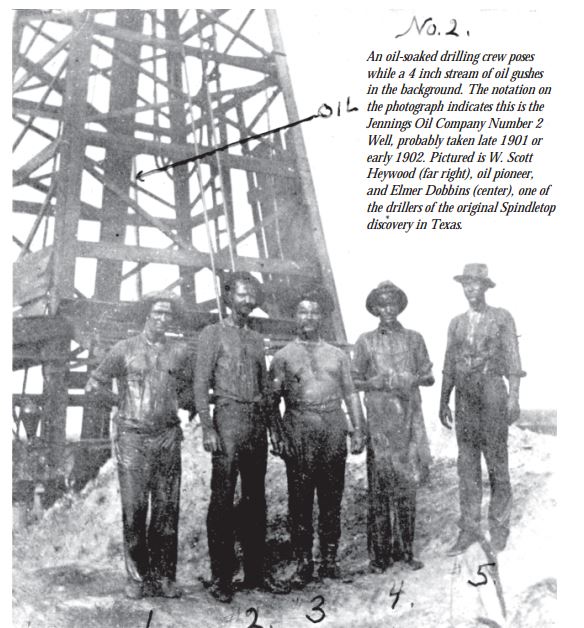
W. Scott Heywood (5) and Elmer Dobbins (3) — “one of the drillers of the original Spindletop discovery in Texas.” Photo courtesy Louisiana Geological Survey.
Although the Jules Clements No. 1 well is on only a 1/32 of an acre lease, it marked the state’s first oil production and launched the Louisiana petroleum industry. It opened the prolific Jennings field, which Heywood developed by securing leases and building pipelines and storage tanks.
The Jennings oilfield reached its peak production of more than nine million barrels in 1906. Meanwhile, an October 1905 discovery in northern Louisiana further expanded the state’s young petroleum industry (visit the Louisiana Oil Museum in aptly named Oil City).

Haywood returned to Alaska in 1908 on a big-game hunting trip. He retraced much of his travels to the Klondike gold fields, notes Smiley. “After a brief retirement in California, he returned to Jennings and drilled several wells at Jennings and elsewhere in Louisiana,” Smiley reports, adding the he also found success at the Borger and Panhandle oilfields in Texas.
“Heywood returned to Jennings in 1927 and assisted Gov. Huey P. Long in passing legislation to provide schoolbooks for children,” concluded the geologist in Jennings Field – The Birthplace of Louisiana’s Oil Industry, September 2001.

Rapid development of the Jennings oilfield in the early 1900s led to new conservation laws. A lack of spacing regulations forced “each leaseholder to drill their own well to prevent the draining of oil from the lease by an adjacent well.” Circa early 1900s photo courtesy Louisiana Geological Survey.
A retired professor challenged the date of Louisiana’s first commercial oil well during a 2011 presentation at Carnegie Library in Sulphur. Thomas Watson, PhD, “has uncovered evidence that the first producing oil well in Louisiana was at the Sulphur Mines in 1886,” noted the Sulphur Daily News.
“This information could alter the history of oil production in Louisiana,” Watson reported.
Offshore Caddo Lake
Gulf Refining Company in 1911 drilled Ferry Lake No. 1 on Caddo Lake, Louisiana, using a fleet of tugboats, barges, and floating pile drivers. When the first well produced 450 barrels of oil per day, Gulf constructed platforms every 600 feet on each 10-acre lakebed (see Offshore Drilling History).

Along with wells on a lake in Ohio, the Caddo Lake wells have been called the birth of America’s offshore drilling industry. Oil was produced from platforms on Grand Lake St. Marys as early as early as 1887 (see Ohio Offshore Wells).
_______________________
Recommended Reading: Louisiana’s Oil Heritage, Images of America (2012); Early Louisiana and Arkansas Oil: A Photographic History, 1901-1946
(2012); Early Louisiana and Arkansas Oil: A Photographic History, 1901-1946 (1982). Your Amazon purchase benefits the American Oil & Gas Historical Society. As an Amazon Associate, AOGHS earns a commission from qualifying purchases.
(1982). Your Amazon purchase benefits the American Oil & Gas Historical Society. As an Amazon Associate, AOGHS earns a commission from qualifying purchases.
_______________________
The American Oil & Gas Historical Society (AOGHS) preserves U.S. petroleum history. Please become an AOGHS annual supporter and help maintain this energy education website and expand historical research. For more information, contact bawells@aoghs.org. Copyright © 2024 Bruce A. Wells. All rights reserved.
Citation Information – Article Title: “First Louisiana Oil Well.” Authors: B.A. Wells and K.L. Wells. Website Name: American Oil & Gas Historical Society. URL: https://aoghs.org/petroleum-pioneers/first-louisiana-oil-well. Last Updated: September 14, 2024. Original Published Date: September 1, 2005.
by Bruce Wells | May 17, 2023 | AOGHS Newsletter




















